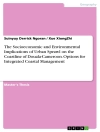This book is part of a six-volume series on Disaster Risk Reduction and Resilience. The series aims to fill in gaps in theory and practice in the Sendai Framework, and provides additional resources, methodologies and communication strategies to enhance the plan for action and targets proposed by the Sendai Framework. The series will appeal to a broad range of researchers, academics, students, policy makers and practitioners in engineering, environmental science and geography, geoscience, emergency management, finance, community adaptation, atmospheric science and information technology.
This volume offers the international guidelines and global standards for resilient disaster risk reduction and lessons learned from disasters, particularly the COVID-19 and Cholera pandemics. A resilient health system and an effective disaster risk management Index are then suggested. The book further emphasizes urban resilience strategies with local authorities, adaptation strategies for urbanheat at regional, city and local scales, and lessons from community-level interventions.
Also addressed are coastal erosion, displacement and resettlement strategies. Land use planning and green infrastructure are suggested as tools for natural hazards reduction. Human security in times of climate change and urban heat at regional, city and local scales is discussed for an integrated action, with case studies based in Manila, Burkina Faso, Chad, Mauritania, Niger, Senegal, Nigeria, India, Spain, and Ghana. Structure design for cascading disasters resulting from mining and flooding is presented and sustainable smart city planning using spatial data is recommended.
Jadual kandungan
Chapter 1. Global Standards for Disaster Risk Reduction.- Chapter 2. Guidelines for Resilient Disaster Risk Reduction: International Law Perspective.- Chapter 3. Strengthening Institutional Resilience: Lessons Learned from COVID-19 Disaster.- Chapter 4. Resilient and Effective Disaster Risk Management Index.- Chapter 5. Mining Hazard Risk Reduction and Resilience.- Chapter 6. Implementing Urban Resilience Strategies with Local Authorities.- Chapter 7. Land Use Planning and Green Infrastructure: Tools for Natural Hazards Reduction.- Chapter 8. Disaster Risk Management: A Resilient Health System.- Chapter 9. Coastal Erosion, Displacement and Resettlement Strategies.- Chapter 10. Resilience and Adaptation Strategies for Urban Heat at Regional, City and Local Scales.- Chapter 11. Combining Disaster Risk Reduction and Climate Change Adaptation for Greater Effectiveness: Lessons from Community-Level Interventions.- Chapter 12. Human Security in Times of Climate Change: Climate Diplomacy for Integrated Action.- Chapter 13. Case-Based Reasoning for Disaster Management: Structure Design for Cascading Disasters Case Base.- Chapter 14. Building Metropolitan Manila’s Institutional Resilience in the Context of Disaster Risk Reduction and Management.- Chapter 15. Exploring Disaster Risk Reduction Strategies In The Sahel: A Multi-Country Study of Burkina Faso, Chad, Mauritania, Niger and Senegal.- Chapter 16. Nexus Between Flooding, Water Quality and Cholera in Nigeria: A Review of Possible Public Health Interventions.- Chapter 17. Sustainable Smart City Planning using Spatial Data and Risk Reduction: A Case Study Siliguri Municipal Corporation.- Chapter 18. Social Representations and Climate Change Teaching in Trainee Social Sciences Teachers.- Chapter 19. Urban Vulnerability to Extreme Heat Events and Climate Change.- Chapter 20. Flooding in Informal Communities Residents’ Response Strategies to Flooding.
Mengenai Pengarang
Dr. Saeid Eslamian is a Full Professor of Hydrology and Water Resources Sustainability at Isfahan University of Technology in the Department of Water Engineering. His research focuses mainly on statistical and environmental hydrology and climate change. In particular, he is working on modeling natural hazards including flood, drought, storm, wind, and pollution toward a sustainable environment. Formerly, he was a Visiting Professor at Princeton University, University of ETH Zurich, and Mc Gill University. He has contributed to more than 600 publications in journals, books, or as technical reports, and he is the Founder and Chief Editor of the International Journal of Hydrology Science & Technology. Eslamian is now associate editor of four important publications: Journal of Hydrology (Elsevier), Eco-Hydrology and Hydrobiology (Elsevier), Journal of Water Reuse and Desalination (IWA) and Journal of the Saudi Society of Agricultural Sciences (Elsevier).
Professor Eslamian is theeditor and author of approximately 35 books and 180 chapter books. The editorship of ten handbooks published by Taylor & Francis (CRC Press): the three-volume Handbook of Engineering Hydrology in 2014, Urban Water Reuse Handbook in 2016, Underground Aqueducts Handbook (2017), the three-volume Handbook of Drought and Water Scarcity (2017), Constructed Wetlands: Hydraulic Design (2020) and Handbook of Irrigation System Selection for Semi-Arid Regions (2020). An Evaluation of Groundwater Storage Potentials in a Semiarid Climate and Advances in Hydrogeochemistry Research by Nova Science Publishers (USA) are also his book publications in 2019 and 2020, respectively.












